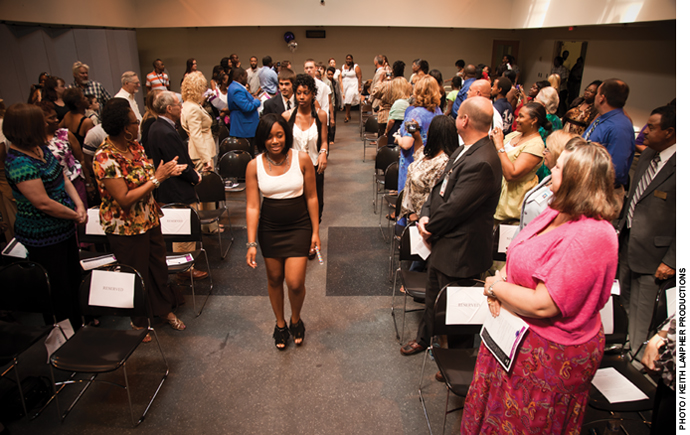Photos: Additional images of Performance Learning Centers (PLCs) in Hampton and Richmond, Virginia.
Eighteen-year-old Tyriq Jones was fairly blunt about the mess he had gotten himself into before transferring to the Hampton, Virginia, online school where I approached him one chilly day this spring. “I got in trouble. I was playing around. I got backed up” in high school, he said. He had failed three classes in his junior year and, faced with the prospect of repeating a year, probably would have dropped out instead, he told me. “I didn’t want that kind of pressure.”
People who deal with at-risk teenagers say dropping out is not an event; it’s a process. Youngsters miss school and get “backed up” in class, so they miss more school because they’re bewildered or embarrassed, and fall further behind. Seeing few ways to recover, “they just silently drop out,” said Richard Firth, who showed me around the Hampton school and two others in Richmond that are using online learning to derail the cycle.
In the three years the 75-seat Hampton Performance Learning Center has been open, it claims to have graduated 91 students. There’s a waiting list for admission, so the school opened a second shift, which also is near capacity. Sherri Pritchard, the school’s social-studies “learning facilitator”—there are no teachers and no principal here—said 95 percent of her online students pass Virginia’s end-of-course history test, which would put them well ahead of both the Hampton school district’s and state’s pass rates.
And Tyriq: He has only a C average after a year at the Hampton PLC, he said, but he graduated in June—on time—and plans to enlist in the Army, his goal all along.
The New Alternative
Online K–12 education made its appearance in the mid-1990s, largely as a resource for bright students who had no access to accelerated classes. It moved next into core high-school courses where districts found themselves with teacher shortages—math, science, foreign languages—and has been growing bumptiously, and in a dozen directions, ever since.
The International Association for K–12 Online Learning, which goes by the acronym iNACOL, estimates that 82 percent of school districts now offer at least one online course. Thirty-two states have virtual schools where online offerings range from one class to an entire high-school curriculum, according to an annual report on online learning published by the Evergreen Education Group, a Colorado consultancy. At the Florida Virtual School alone, students collectively took 220,000 classes online in 2009–10 (see “Florida’s Online Option,” features, Summer 2009). Twenty-six states have at least one full-time online school, and perhaps 225,000 youngsters were full-time online students this year, says John Watson, editor of the Evergreen report.
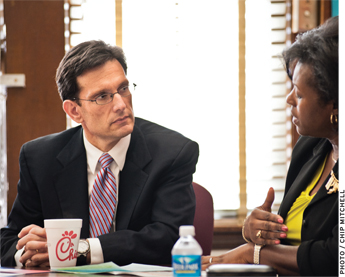
Two of the fastest-growing trends in online education converge in the Performance Learning Center project, which is why I called Communities in Schools, a nonprofit dropout-prevention program that devised the model in Georgia in 2002.
The PLCs call themselves an alternative to traditional schools and distance themselves from the credit-recovery factories that many districts have opened to boost their graduation rates ahead of state and federal sanctions. (Indeed, a few PLC students enroll for the chance to accelerate.) But the schools do offer struggling kids like Tyriq a chance to make up courses they failed in traditional teacher-student classrooms, which puts them at the nexus of a national debate. States are raising their graduation standards, but returning kids to the classroom for a second attempt at algebra often is counterproductive—Why should we suppose they’ll understand equations any better the second time around?—and gobbles up teacher time.
The second trend is the “blended” approach, combining online learning with a teacher-led classroom (see “Future Schools,” features, Summer 2011). Most instruction is online in the PLC model, but a teacher-coach is there to answer questions, direct projects, and keep kids on track.
Communities in Schools linked those two trends with the small-school idea and has expanded the project to seven states and 33 schools. PLCs have only four or five classrooms, four or five teachers, and fewer than 100 students. Teachers are district employees who are paid the district scale and apply for their jobs. Kids remain part of their home schools, which has raised graduation statistics for those schools and generated buy-in from their administrators.
PLCs generally receive the same per-pupil funding as traditional schools. Their biggest expense, after salaries, goes to licensing fees for the online curriculum, which Richard Firth, the Virginia PLC director, put at about $35,000 a year per school. Start-up costs for computers, teacher training, and to carve new schools out of old facilities can be a showstopper for financially pressed school districts. Richmond, which is building its first new high school in 40 years, plans to include some multipurpose rooms that could be used for a future PLC.
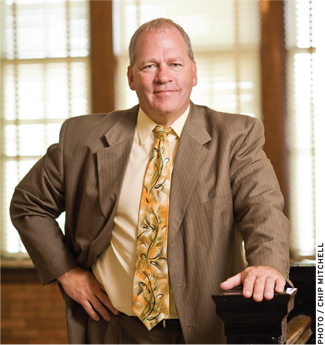
The only outside funding comes from Communities in Schools, which pays the salary of a services coordinator, who links youngsters with housing, day-care, medical, and other service providers and helps them plan what they do after graduation. The services coordinator at the Richmond career-center PLC keeps a closet of baby clothes in her office for students whose own children can attend Head Start or day care downstairs.
Almost disarmingly, the PLCs reach out to youngsters that schools typically find the most troublesome. Sherman Curl, the academic coordinator—i.e., principal—at the Adult Career Development Center PLC in Richmond, handed me a brochure describing the students for whom the PLC is a good fit. Kids with “poor attendance,” “excessive tardiness,” “academic failure,” “apathy,” “social issues,” low motivation, and such “challenges to success” as pregnancy and poverty, it read.
In a summary of its 2009–10 academic year, Virginia’s Communities in Schools reported that one-third of the students at its four PLCs were at least two years behind in academic credits when they arrived. They were a year or two older than their conventional-school peers and, in the previous year, averaged six suspensions and 24 absences each at their former schools. Several youngsters told me they’d fallen in with the wrong crowd at their old schools, or they felt bullied and isolated. “I started messing up,” a chatty 18-year-old named Chelsie Saunders told me at the Hampton PLC, which is housed in a modern teen center, complete with pool tables, a basketball court, a coffee bar, and an airy television lounge with leather sofas.
“These are kids who never made it in a comprehensive school,” said Wes Hamner, the academic coordinator at the Richmond Technical Center PLC, which occupies one floor of a sprawling trades-training campus in Richmond’s industrial district.
For all that, the three PLCs I visited were remarkably quiet and orderly: There wasn’t much chatter about what kids were learning, but there wasn’t any catcalling, hallway scuffling, or acting out in class, either. Hamner pointed out that there’s no security at his school and that the lockers don’t even have locks. Teachers sat in the back or in a corner of the classrooms, while students sat at computers, wearing headsets.
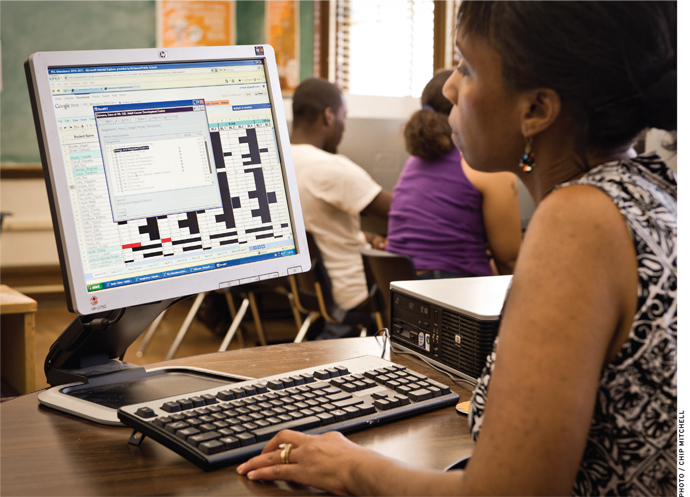
Teaching to the Student
At Hampton, I asked Pritchard, the social-studies facilitator, how she knew what her students were doing, so she opened a dashboard on her computer. It showed that on computer 3, a student was working on a U.S. history unit, or “module,” on civil rights. The teenager on computer 6 was working on a module on imperialism for the same course, and the student on computer 7 was doing a review and practice test on the executive branch of the U.S. government.
Most PLCs, including those in Virginia, use NovaNET, an online curriculum that is marketed by Pearson Education Inc. The program tests a student at the end of each lesson, module, and course, and lets those who pass their tests with at least an 80 percent move on. For those who don’t pass, the computer singles out the content they seemed not to understand, reteaches it, and retests.
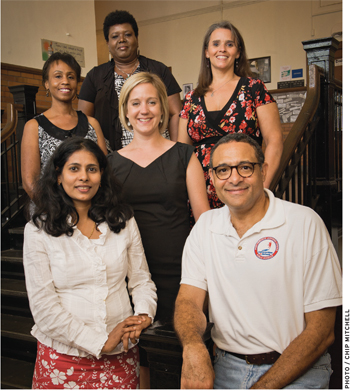
Kids like the immediate feedback, Katherine Fox, the academic coordinator at Hampton, told me: “It’s difficult for them to wait for success. Kids want to move on.” A mop-haired boy named Michael told me that he used to obsess over test questions at his conventional school and couldn’t force himself to move ahead. The NovaNET practice tests and make-up tests relieved him of that anxiety, he said, as he pulled certificates from his backpack to show that he had completed two business classes, oceanography, and biology. “No one gets left behind here,” he said.
Back on Pritchard’s dashboard, meanwhile, I could see that the student on computer 1 was using an open-source educational website called SAS Curriculum Pathways to research voting rights for the government class, while the student on computer 2 was researching Appomattox on SAS for history class. Most Hampton PLC computers can access only NovaNET; the few that can access SAS can’t go any further than research sites to which SAS provides a link.
At the career center PLC in Richmond, which is housed on the top floor of a 1920s-era school built for the city’s elite black students, science facilitator Patricia Sessions showed me more. A “pacing sheet,” a sort of minimum speed limit set by the state education department, suggested that teachers should expect to devote three weeks to a unit on biochemical processes, part of the biology curriculum. But when Sessions opened the computer file of a student named Trish, it showed that Trish had finished the unit in a week. She’d spent 26 minutes on an online lesson about atoms and molecules, and got a 90 on the test. She’d spent an hour on the properties-of-water lesson and another hour on acids and bases, and got 80 on both.
Teachers told me that most NovaNET courses are comparable to textbook-based courses in length and content—a comeback to critics who talk of watered-down curricula at alternative schools—but that many students move through them more quickly, and often finish high school a semester early. “I’m constantly working rather than waiting,” explained a tattooed girl named Shaina at the Richmond Tech school.
Pritchard told me that she started the school year with students grouped largely by subject—say, geography in one period, government in another. But as the year went on, and students progressed at different speeds, classes became more diverse. In any class period now, she could have youngsters working on either semester of any of four subjects.
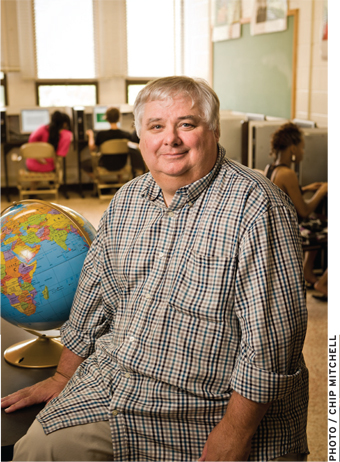
As students finish courses, they can move to another classroom to work on courses they may find slower going. If they earn enough credits to graduate before the school year is over, the services coordinator steers them to mentorships, trade training, or jobs. Sessions, who was playing Mendelssohn in her otherwise-silent classroom as her students worked, said she started the year with 20 kids in her afternoon class and was down to 8 by late March.
All that movement precludes lectures or class discussions. Teachers told me that anywhere from 60 to 90 percent of the work in their classrooms is done online, with work sheets, projects, one-on-one meetings, and, for seniors, a research report and presentation accounting for the rest. The walls of Pritchard’s classroom were ringed with poster-board projects on the Zhou Dynasty, the Battle of Fort Fisher, and the roles of the secretary of defense and the U.S. Department of Education, among others. It wasn’t AP material, perhaps, but it showed persistence and attention to detail that are not always common in city schools. Last year, the whole school read the same book, Facing the Lion, and used it as a springboard for cross-disciplinary studies.
The students I talked with said they didn’t miss discussions or were self-aware enough to know that lectures didn’t fit their learning style. “I wouldn’t be listening anyway,” Tyriq told me; “I’m not a person to talk,” said another 18-year-old named Dashawn. Instead, kids said they liked the anonymity and independence of working online. “I like being in my own bubble,” Chelsie Saunders told me in Hampton: “I don’t like waiting on people” on some lessons and “I don’t worry about people getting frustrated with me” for working slowly on others.
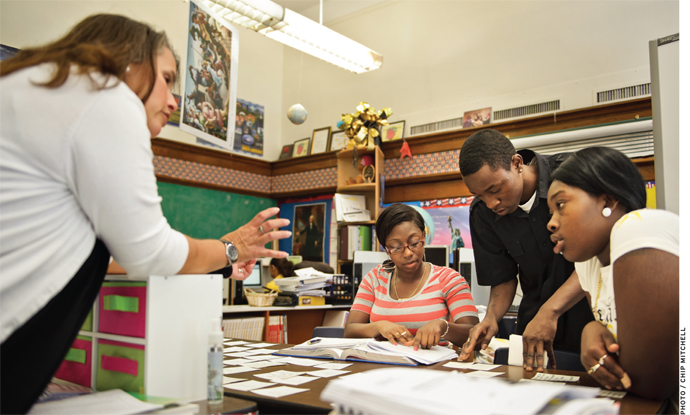
A Promising Start
The PLCs take youngsters who have at least attempted 9th grade, plus a few overage 8th graders. But most kids arrive in 10th or 11th grade when they realize they’re not on track to graduate. For admission, they must score at an 8th-grade level on standardized reading and math tests (the Richmond Tech PLC raised that to 9th grade because it had so many applicants), pass an interview, and sign an achievement contract that also commits them to attend a daily meeting called Morning Motivation. Each gets a learning plan that plots an individual path to graduation and then to a trade program, a job, or college.
Yvonne Brandon, superintendent of Richmond City Schools, expressed enthusiasm for online learning when we spoke. “We have to transform our ideas of what learning looks like,” she said. But PLC staffers told me that the districts sometimes struggle to understand them. Grade levels, quarterly grades, GPAs, and the academic calendar are fuzzy at a move-at-your-own-pace school: Youngsters told me how many credits they had, not whether they were juniors or seniors.
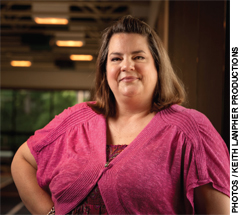
Students graduate when they earn the state-mandated 22 credits, but they can’t receive diplomas until spring. Firth, the Virginia PLC director, said he recently learned that some of those graduates-without-diplomas were being counted as absent by the district because, well, they weren’t in school. “We’re so outside the box and education is so inside the box,” Hamner sighed.
The data on online education are still pretty equivocal. There are no data on what kind of student performs best in an online class, although everyone I talked with assumed it probably was the independent achiever, because that kind of student performs well in any setting. There are few quality measures, although Michael Horn, executive director for education at the Innosight Institute, a Mountain View, California, think tank, points out that we don’t know how to measure quality in face-to-face classes, either.
Barbara Means of SRI International, a research institute in Menlo Park, California, told me that much of the ambiguity is because state data systems aren’t set up to compare online learners to in-class learners. They don’t record which students taking the state’s standardized math tests completed them at the end of an online course, for example, and which took them after a face-to-face class. Most states don’t keep student-level data, so researchers also can’t compare similar students at a full-time virtual school and those in a full-time conventional one.
Means reviewed 12 years of literature on online learning and said that from the limited data they presented she concluded that “there wasn’t much difference” in the educational outcomes of kids who studied online and those who studied in a classroom. That suggests that schools should consider some other reason if they’re thinking of shifting curriculum or students online, she said: Perhaps it’s cheaper or there are social benefits, like making school more flexible for working students or for those with infants.
Means also surveyed the literature comparing outcomes at traditional schools to outcomes at schools that blended face-to-face and online teaching. Youngsters in the blended environments, with a teacher and technology, did “significantly better,” she said. But that may be because blended schools offered youngsters more learning time, more content, or perhaps both, rather than because of the different approach to teaching.
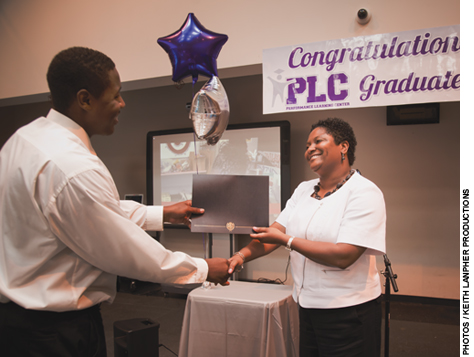
Credit-recovery and online programs have been accused of low standards and a weak-tea curriculum, anything to get kids into the graduation statistics, critics contend. But the PLCs insist on the rigor of their program because it’s based on a general-education curriculum, not a credit-recovery curriculum. PLC students take the same state tests as their traditional-school peers. And computer testing on NovaNET and other online curricula prevents social promotion or the intervention of soft-hearted administrators. “We legally graduate kids; I don’t do them any favors,” said Wes Hamner at Richmond Tech PLC.
In a report on the 2009–10 school year, the project says that, nationally, its students improved their scores in all four core subjects compared to their performance in their home school the year before—by from 6 to 11 percentage points—and that 96 percent of the students classified as seniors at the beginning of the school year graduated. For a project that works with potential dropouts, that’s hugely impressive, but there has been little outside research on the PLCs that would confirm that.
The results at the Virginia PLCs are equally ambiguous. In 2009–10, the 432 youngsters who attended the four schools arrived with D averages in math, English, science, and social studies, and, except for math—which was still stuck in the basement—raised them to a C. But the averages include the 30 percent of kids who dropped out, switched to a GED program, or left for some other reason, probably lowering the grades.
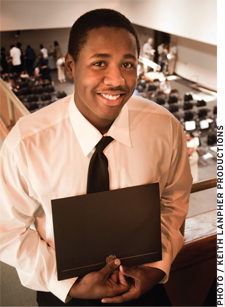
The PLCs also reported that 96 percent of their students passed Virginia’s end-of-course algebra exams, 97 percent passed reading, 90 percent passed biology, and 100 percent passed writing. That would put the PLCs ahead of state averages in all four subjects. (The results say a lot about Virginia’s learning standards: Is it really possible that only 6 percent of the state’s 400,000 high schoolers failed reading and 6 percent failed Algebra I last year?) The scores of PLC students are included in the results of their home schools, which makes them difficult to verify. The PLCs also don’t accept English-language learners, kids with discipline problems or most disabilities, or those with elementary-level reading and math abilities, as other public schools must, which muddies the comparison.
Still, more than one-third of the youngsters who started at the Virginia PLCs in fall 2009 graduated in 2010, including 68 students who headed to two- or four-year colleges, the Virginia project reported.
When I spoke with Chelsie Saunders in Hampton in early spring, she laid out a career path that included community college, university, and then a career in teaching or nursing. “Honestly, if it wasn’t for here, I wouldn’t graduate,” she told me. When I checked back in June, she had.
June Kronholz is a former Wall Street Journal foreign correspondent, bureau chief, and education reporter, and currently a contributing editor at Education Next.
This article appeared in the Fall 2011 issue of Education Next. Suggested citation format:
Kronholz, J. (2011). Getting At-Risk Teens to Graduation: Blended learning offers a second chance. Education Next, 11(4), 24-31.


